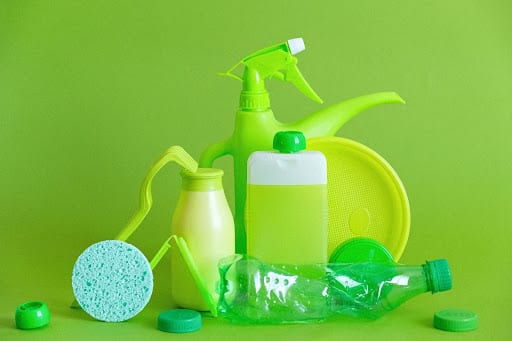Self Care this Autumn: the benefits of the return of rituals and routines
Self Care this Autumn: the benefits of the return of


Scence Co-Founders
Look in your kitchen cupboards, bathroom cabinet and inside your wardrobe; you’ll see swathes of labels and printed packaging. How many of those labels are shouting about being ‘recyclable,’ ‘sustainable,’ ‘responsible’ or ‘eco-friendly’?
Next question: is what’s on the label actually true?
Last year environmental activist, Greta Thunberg heavily criticised international climate summits calling them out as “loopholes, empty words and greenwash.”
With so much talk around the government’s 2050 net zero pledge, corporate ‘greenwash’ or ‘greenwashing’ is one of the areas of reform in the spotlight. Remaining truthful and transparent to consumers has never been more important.
Below we’ve laid out the basics to help you understand what greenwashing is, how to spot it and why, through our business, we’re ‘making Scence’.

What is greenwashing?
Corporate greenwash is when companies advertise themselves as being eco-friendly, sustainable or a myriad of other ‘green’ terms to appear environmentally friendly, contradicting their actual practice.
The Cambridge Dictionary definition reads ‘to make people believe that your company is doing more to protect the environment than it really is.’
Where did greenwashing come from?
In 1986 Jay Westerveld wrote an article in which the phrase ‘greenwashing’ was born. Whilst travelling, Jay found a card in his hotel room which said “Save Our Planet: Every day, millions of gallons of water are used to wash towels that have only been used once. You make the choice: A towel on the rack means, ‘I will use again.’ A towel on the floor means, ‘Please replace.’ Thank you for helping us conserve the Earth’s vital resources.”
Jay didn’t see this hotel’s campaign as saving the planet, he saw it as the hotel trying to save money, negating the environmental impact of the energy and resources it takes to actually wash a towel.
The hotel wanted the perception of being environmentally friendly rather than “truly being green…wash my towels please, just don’t ‘greenwash’ me.” said Jay.
Why is greenwashing a bad thing?
Simply put, if a consumer continues to buy from a brand because they believe that they are buying ethically or in an environmentally-friendly way, then they will carry on spending with that brand, unaware that they are potentially contributing to harmful activity.
Additionally, in today’s market, being ‘environmentally friendly sells.’ It is problematic because the ever-increasing environmentally conscious consumer demands that the products they buy tick all the eco-credential boxes, and they’re often willing to pay more for it, so more brands are applying this form of deceptive greenwash across their marketing to generate higher profits.
Want to see greenwashing in practice? Click here to read about greenwashing from global companies Shell, BP and Ryanair who have been caught in the act.

How can you spot greenwashing?
Take the ‘green’ product in your kitchen cupboard, for example, check out the imagery on the packaging. You might see green leaves, wide open spaces, animals grazing in green field or even those green recyclable arrows. If it’s unsubstantiated, this is greenwashing – using imagery to portray being environmentally-friendly but not actually being so.
Consider the language that the brand is using to portray its eco-credentials. It should be simple enough to understand and not clouded in technical ambiguity or overzealous marketing slogans. Become a green-skeptic and trust your gut, if it doesn’t sound right then it probably isn’t.
The brand should also be able to back up its claims; do some more research on their website for clarity on what they are saying. Ask them directly for information and certifications, if they can back it up, they’ll be happy to share it with you.
Keen to recognise more signs of greenwashing? Check out this helpful article about the seven sins of greenwashing.

So, what about us? What are Scence doing to remain transparent?
We promise to use only the highest quality, natural and organic ingredients that are both nourishing for your skin and kind to the environment.
We’re vegan. There are lots of beautiful plant & mineral-based alternatives which mean we don’t need to use ingredients derived from animals.
We don’t use plastic. We’ve worked with a UK packaging producer to perfect our paper tubes & jars. Our natural, eco-friendly packaging is more than recyclable, it’s 100% domestically compostable so we ensure we aren’t adding to the single-use plastic problem in the world.
We don’t compromise. From choosing the highest quality ingredients, to keeping our products free from parabens, aluminum, and any other nasties, we’re committed to creating products that do good, with no compromise.
Take a look at websites such as https://wherefrom.org/ which can help you research brands so you can find sustainable alternatives and be a conscious consumer (you’ll find Scence on there too, hurrah!)
Self Care this Autumn: the benefits of the return of
HOW TO LOOK AFTER DRY, ITCHY OR ECZEMA SKIN Taking
Are you worried about hidden plastics in the cosmetic industry?
Sign up to our newsletter to receive exclusive offers and skincare tips.
Copyright ©Scence Skincare 2024 | Website by Solve Web Media | Designed by The Fastnet Agency
| Cookie | Duration | Description |
|---|---|---|
| bcookie | 1 year | LinkedIn sets this cookie from LinkedIn share buttons and ad tags to recognize browser ID. |
| bscookie | 1 year | LinkedIn sets this cookie to store performed actions on the website. |
| LANG | 9 hours | Linkedin set this cookie to set user's preferred language. |
| li_gc | 5 months 27 days | Linkedin set this cookie for storing visitor's consent regarding using cookies for non-essential purposes. |
| lidc | 1 day | LinkedIn sets the lidc cookie to facilitate data center selection. |
| nsid | session | This cookie is set by the provider PayPal to enable the PayPal payment service in the website. |
| TawkConnectionTime | session | Tawk.to, a live chat functionality, sets this cookie. For improved service, this cookie helps remember users so that previous chats can be linked together. |
| tsrce | 3 days | PayPal sets this cookie to enable the PayPal payment service in the website. |
| twk_idm_key | session | Tawk set this cookie to allow the website to recognise the visitor in order to optimize the chat-box functionality. |
| UserMatchHistory | 1 month | LinkedIn sets this cookie for LinkedIn Ads ID syncing. |
| X-AB | 1 day | Cookie associated with embedding content from Snapchat. |
| x-pp-s | session | PayPal sets this cookie to process payments on the site. |
| Cookie | Duration | Description |
|---|---|---|
| __kla_id | 1 year 1 month 4 days | Cookie set to track when someone clicks through a Klaviyo email to a website. |
| _gat | 1 minute | This cookie is installed by Google Universal Analytics to restrain request rate and thus limit the collection of data on high traffic sites. |
| l7_az | 30 minutes | This cookie is necessary for the PayPal login-function on the website. |
| Cookie | Duration | Description |
|---|---|---|
| _ga | 1 year 1 month 4 days | The _ga cookie, installed by Google Analytics, calculates visitor, session and campaign data and also keeps track of site usage for the site's analytics report. The cookie stores information anonymously and assigns a randomly generated number to recognize unique visitors. |
| _ga_* | 1 year 1 month 4 days | Google Analytics sets this cookie to store and count page views. |
| _gid | 1 day | Installed by Google Analytics, _gid cookie stores information on how visitors use a website, while also creating an analytics report of the website's performance. Some of the data that are collected include the number of visitors, their source, and the pages they visit anonymously. |
| AnalyticsSyncHistory | 1 month | Linkedin set this cookie to store information about the time a sync took place with the lms_analytics cookie. |
| CONSENT | 2 years | YouTube sets this cookie via embedded youtube-videos and registers anonymous statistical data. |
| Cookie | Duration | Description |
|---|---|---|
| _fbp | 3 months | This cookie is set by Facebook to display advertisements when either on Facebook or on a digital platform powered by Facebook advertising, after visiting the website. |
| fr | 3 months | Facebook sets this cookie to show relevant advertisements to users by tracking user behaviour across the web, on sites that have Facebook pixel or Facebook social plugin. |
| NID | 6 months | NID cookie, set by Google, is used for advertising purposes; to limit the number of times the user sees an ad, to mute unwanted ads, and to measure the effectiveness of ads. |
| Cookie | Duration | Description |
|---|---|---|
| m | 1 year 1 month 4 days | No description available. |
| wp_woocommerce_session_37126b948e5afd3a014d768c2654215c | 2 days | No description |